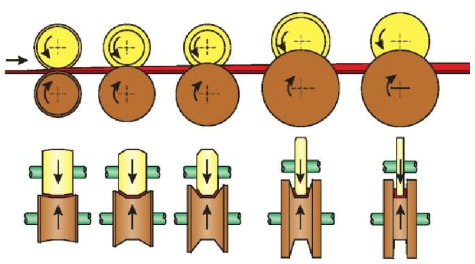Roll forming is a continuous process
Roll forming is a continuous process that employs a series of paired roll tools to progressively shape a flat strip of metal into a desired profile. The process of progressively shaping the strip is called ‘Flowering’ as gradual change in shape appears on a continuous strip as it passes through different stages of the process.
Cold Roll Forming Process
Figure: Cold Roll Forming Process

Cold roll forming holds an edge over the other production methods as it is a continuous process that eliminates stage production, finishing and sub-assembly operations. It also offers the following advantages:
Complex geometrical shapes can be produced
Better consistency and accuracy are achieved
Versatility in thickness and length
Increased strength due to strain hardening
Lightweight with rigidity saves material and cost
Secondary operations can be combined in the continuous operation– speeds up production
Both ferrous and non-ferrous metals can be roll formed
Avoids secondary coating as galvanized, vinyl coated or plastic enclosed metal can be roll formed
Increased manageability
Maximum straightness
Closer tolerances
Better surface finish
Cold roll formed products have already found their applications in various industries and are finding new applications everyday. They have replaced many conventional methods for the betterment. Some of the applications for the roll formed products are as under:
Automobile Industry:
A variety of sections are used in automobiles for making chassis, body, floor panels, side panels, stiffeners, cable trench etc.
Civil Construction:
Nowadays industrial sheds use a lot many different sections e.g. Z – purlin and C – purlins are extensively used for shed construction, Shaped Sheets are used for cladding and roofing, Frame sections are used for door and window frames, Channels are used for columns and crane girders, Decking Sections are used for flooring, Shutter Sections are used in rolling shutters etc.
Frame sections, Interlocking Beams, Columns etc find their applications in domestic construction also.
Electrical Industry:
Din channels are used for fixing MCBs and MCCBs. Terminal channel and Lipped Channels are used for cable trench. Various intricate sections are used as busbars in overhead applications and for electrification of the railways.
Textile Industry:
Textile industry uses sections like Open Square Pipe and Triangular Creel in the ring frame of spinning machine.
Storage System:
Strut sections, Lipped Channels, Slotted Rack Sections etc are used for preparing different types of racks. Light Weight Pallets are also made of steel sections. Shaped sheets are used in manufacturing of the containers.
Conveying System:
Many different sections are used in different industries to carry different liquid and solid goods. Lipped Channels, Conveyor Rails, Sigma Section, Strut Sections, U – sections, M – Sections etc are used in conveying systems.
Furniture and Office Equipment:
Many aesthetic sections are used nowadays in office and housing furniture. Sections are used for making cabins, partitions etc.
Pollution Control:
A lot of industries now use air purifier for the electrostatic precipitations. Collecting electrodes made of Special Electrode Section are used in the Chemical Plants and Cement Industries for this purpose.


